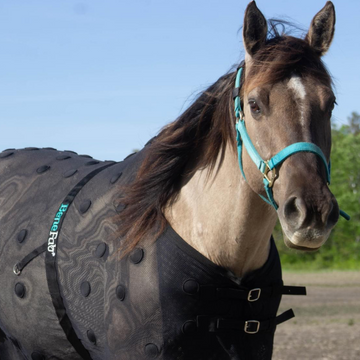The sacroiliac joint, usually called the SI joint, is located where the hind legs meet a horse's spine. It is the major axis for weight and force for the hindquarters. Because of the strain on this joint, it is lined with cartilage to allow cushion between the large bones. It also has a complex structure of ligaments to stabilize and support the joint and hindquarters.
Causes of Sacroiliac Joint Pain

The SI joint carries the major weight and load force of a horse’s back and hindquarters. Without a doubt, one of the causes of SI pain is wear and tear. Older horses and those suffering from degenerative joint disease and inflammation will suffer from this joint pain. Additionally, injuries to the joint, poor saddle fit, and abnormal mechanics can damage the SI joint, which causes pain.
Symptoms of Sacroiliac Joint Issues
In the early stages and with mild conditions, symptoms of SI joint issues can be minor. However, without proper treatment, the symptoms can worsen. Some early symptoms to watch for are:
- Signs of discomfort
- Shortened stride
- Poor performance
- Signs of pain
- Difficulty standing
- Stiffness
- Behavioral issues
- Reluctance to exercise
- Lameness
Diagnosing Sacroiliac Joint Pain
Early diagnosis of SI joint pain is the most essential tool for preventing pain and long-lasting injury in your horse. Diligent ownership and regular checkups will also help. Contact your veterinarian immediately if you believe your horse is suffering from SI joint pain. Your veterinarian will begin with a physical exam and history. After feeling the joint, she may order imaging. Ultrasound and X-rays are excellent diagnostic tools for identifying damage to the ligaments, cartilage, and bones.
During the physical exam, your veterinarian will palpate the sacroiliac joint to check for abnormalities, pain, and inflammation. Additionally, she may wish to observe your horse’s gait through a walk and trot to identify limping, pain, and reduced movement.
In rare cases, your veterinarian may recommend a diagnostic procedure called an analgesia test. In this test, the veterinarian injects a local anesthetic directly into the SI joint. This relieves pain and confirms that this joint is the cause of the pain.
Treatment Options
Physical Therapy and Rehabilitation
A combination of physical therapy and anti-inflammatory drugs can relieve most minor cases of SI joint pain. Physical therapy will combine exercises to improve range of motion and strength with rest. Physical therapy has been proven to reduce inflammation and increase blood flow. With improved mobility and reduced inflammation, your horse should feel less pain quickly. Additionally, you can combine massage and stretching with your physical therapy plan.
Surgical Interventions
In severe cases, surgery may be the best option. A surgical veterinarian removes damaged tissue or fuses the joint together in these instances. Both options will help reduce the pain felt by your horse.
Prognosis for Affected Horses
The prognosis for a horse suffering from SI joint pain varies based on the severity of the true cause. If caught early, with rest and physical therapy, your horse should have no issue returning to full strength and activity. Pain management may be the veterinarian’s and owner’s goal in later stages. You will likely not see a complete return to activity for horses treated with surgery. However, you will see significant improvement in pain and behavior.






















